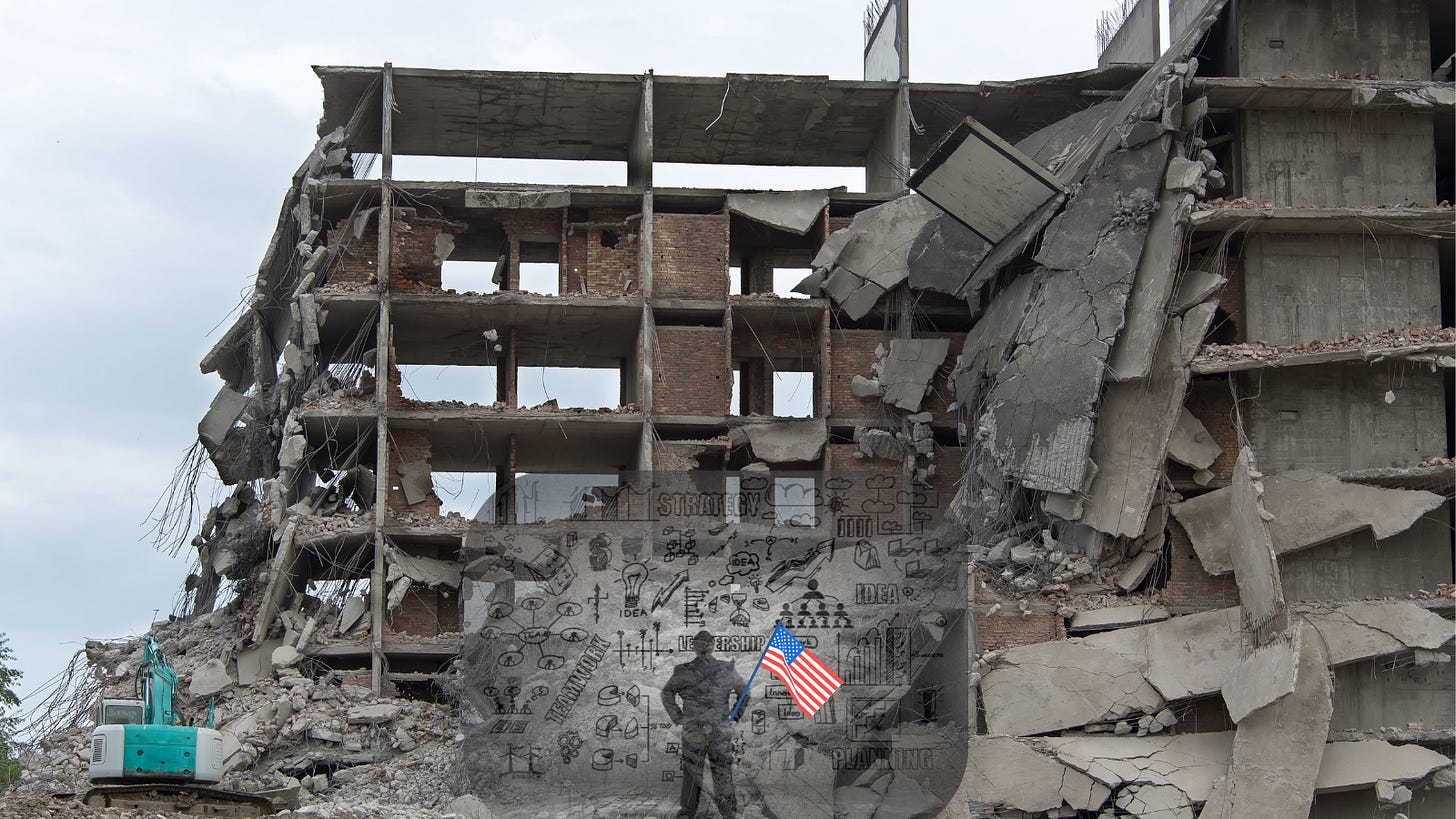Trump Brought the Ceasefire. Can America Bring the Peace?
Hostages are home, now comes the test we’ve never passed.
Let’s start with what’s real: Donald Trump and his team deserve credit for negotiating a ceasefire and bringing home hostages.
Yesterday, all 20 living Israeli hostages were released in exchange for nearly 2,000 Palestinian prisoners, a monumental moment in this war’s arc.
But pause and ask: why doesn’t the broader U.S. narrative also remind us that the Biden administration helped bring home over 100 hostages in earlier exchanges? Politics, as ever, picks who gets the credit. We should call out both, not as partisan points, but as facts.
So yes, this deserves applause. Let’s hope the ceasefire holds. But the more complex question is: will it? And what happens next if it does?
The consensus in the national security circles I’m in and the current discussions in Washington is cautious. The ceasefire may hold for weeks or months, but the governance gaps and competing factions inside Gaza could easily unravel it.
Hamas’ political wing may want stability, but its military brigades and groups like Palestinian Islamic Jihad often act independently. Add to that the lack of a credible international monitoring force, the uncertainty over who will govern Gaza “the day after,” and the jockeying among regional actors like Iran, Qatar, and Egypt, and you have a deal that’s fragile by design.
Some analysts see this as a necessary pause, not a durable peace. Others argue that Trump’s personal involvement, and the “wealth in the room,” as he called it, may give this deal more staying power because of the money and political capital tied to it.
But most agree: the bigger challenge isn’t stopping the fighting. It’s what happens when the rebuilding begins.
I’ve Seen This Movie Before
Today, you know me as former Vice President Mike Pence’s homeland security and counterterrorism advisor, turned Trump critic and democracy advocate. But in 2003, most people knew me as Ambassador Paul L. Bremer’s aide during the early stages of Iraq’s reconstruction, from the planning rooms in Washington to the streets of Baghdad.
I lived that mission firsthand. I saw how idealism, bureaucracy, and politics collided, and how decisions made in air-conditioned conference rooms unraveled on the ground. That’s why I say, with some painful clarity: the United States is not built to rebuild nations.
The Part We Never Get Right
If this ceasefire holds, the next test won’t be about diplomacy. It’ll be about whether the United States and its partners have learned anything from decades of failed “postwar reconstruction.”
America has profound institutional handicaps when it comes to rebuilding nations. We are brilliant at projecting force, and terrible at sustaining peace. Here’s my food for thought on why.
1. Short Political Time Horizons. Congress doesn’t reward ten-year rebuilds. Support dries up once the cameras leave. What begins as commitment often dissolves into fatigue.
2. Siloed Institutions. The U.S. foreign policy apparatus is fragmented and now gutted. USAID has been shuttered, the State Department and the Pentagon (let’s not forget the current amateur leadership in that building) all pull in different directions. There’s rarely a single, coordinated strategy that integrates security, governance, and economic recovery.
3. Contracting Over Capacity. Reconstruction money often flows through massive contractors, many whom are American. Some may cheer for that and say that it helps Americans. But does it really? The incentive structure is to bill hours, not build institutions. That breeds corruption and resentment.
4. Imposed Models, Not Local Ownership
We parachute in constitutional templates and public-sector reforms that look good in Washington but make little sense on the ground. Without local legitimacy, those institutions collapse the moment we step back.
5. Security Before Stability
Development depends on security. But stability becomes a mirage when the security forces are foreign, distrusted, or predatory.
6. The Withdrawal Trap
When we leave, everything we built starts to crumble. We’ve seen it from Kabul to Baghdad; structures without sovereignty don’t last.
A Pattern of Failure
The record is painfully clear:
Iraq: $60 billion in U.S. reconstruction aid; a democracy that slid into sectarian war.
Afghanistan: $145 billion spent; the Taliban returned within weeks of U.S. withdrawal.
Libya: Intervention without a plan to rebuild, resulting in a decade of civil war.
Haiti: Decades of short-term U.S. missions, none delivering sustained governance.
Ukraine (ongoing): Billions in pledged aid, but corruption and procurement scandals already emerging.
Not every U.S.-led reconstruction ended in total collapse, but even our most stable examples reveal the same pattern. If there’s one partial exception, it’s Kosovo.
After NATO’s 1999 intervention, the U.S. and its allies didn’t just leave, they stayed. For over two decades, American troops and diplomats have helped maintain peace, train police, and guide political institutions under NATO’s Kosovo Force (KFOR) and the United Nations Interim Administration Mission in Kosovo (UNMIK). Violence largely stopped, democracy took root, and Kosovo declared independence in 2008.
But even that “success” came with asterisks: Kosovo still isn’t recognized by Serbia, Russia, or several EU states, its economy depends on aid and remittances, and corruption remains endemic. In other words, peace lasted because we stayed to police it, not because the system rebuilt itself.
And now, there is Gaza, home to so many whose lives have been shattered beyond recognition. Ninety percent of its infrastructure lies in ruins, its governance contested, and its future debated by outsiders.
The Sharm el-Sheikh summit spoke of peace, but it sounded like an investment pitch.
🌍 Gaza: The Next Test
If Gaza becomes the next laboratory for American-led “reconstruction,” success will depend on breaking every pattern that has doomed previous efforts. Success would mean:
Rebuilding infrastructure and legitimate local governance.
Transparent procurement and anti-corruption mechanisms.
A credible security force trusted by the population.
A phased transition to local control, not indefinite outside management.
Failure will look like:
Foreign contractors draining donor funds.
Shiny infrastructure projects without functioning institutions.
Renewed violence the moment foreign attention shifts.
Every previous U.S. effort, from Iraq to Afghanistan, fell apart because it chased speed and optics over legitimacy. Gaza will test whether we’ve learned that lesson.
What Comes After the Fire
Trump’s “wealth in the room” line wasn’t just metaphorical, it became a signal. Markets have heard it, and they’re already moving accordingly. While diplomats celebrate peace, traders are already repositioning. The real money won’t be in arms but contracts, logistics, and rebuilding deals. The player to watch: Jared Kushner. What does a Gaza Rivera look like in the future?
The same financial forensics that flagged pre-war speculation will now track post-war profiteering. We’re already seeing the first signs: crude prices are easing, defense stocks are cooling, and investors are pricing in a lower war premium as markets digest Trump’s ceasefire announcement.
Trump brokered a ceasefire and helped bring hostages home; that’s worth acknowledging. But if the United States can’t finally learn how to rebuild, not just destroy, this will be another chapter in a book we’ve written for decades.
Wars end in headlines. Peace survives in institutions, and we don’t rebuild those very well. We don’t build nations, we rebuild them badly.
P.S. I’ve been thinking about all of this while on a 30-hour road trip—listening to the coverage, scribbling notes, and trying to ignore the fact that I’m definitely that passenger who gets carsick. If I managed to stay eloquent despite that, I’ll count it as a win.
Until next time,
Olivia




Well written Olivia 👍
I will share this with my friend in Palestine, who conveyed to me that they don’t want Trump coming in and taking over the Gaza Strip. I don’t doubt this is a transactional move by Trump. If only he really cared about human lives like he does money and power. If he did, Jan 6 would not have happened
Remember when Jimmy Carter was trying to bring back the American hostages held in Iran? And then we learned that the Reagan people were "negotiating" secretly about NOT releasing them until Reagan won? He did, and the hostages were released within minutes of Reagan being sworn in?
This feels the same. I give no credit to Trump. This is a real estate deal brokered by Witkoff. As we were told months ago. These people give no shits about humans, only land, money and beneficial deals.
These hostages were used as they were 45 years ago. I would love to be proven wrong, but with these players, my cynic-o-meter ramps up to 11.